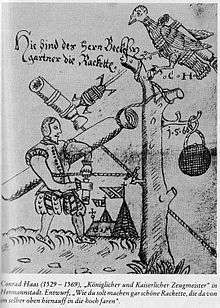Conrad Haas

Conrad Haas (1509–1576) was an Austrian or Transylvanian Saxon military engineer for the Kingdom of Hungary and Principality of Transilvania.
He is a pioneer of rocket propulsion. His designs include a three-stage rocket and a manned rocket.
Haas was perhaps born in Dornbach (now part of Hernals, Vienna). He held the post of the Zeugwart (arsenal master) of the Imperial Austrian army under Ferdinand I. In 1551, Stephen Báthory, the grand prince of Transylvania invited Haas to Hermannstadt, Siebenbürgen (now Sibiu, Transylvania, Romania), where he acted as weapons engineer and also he started to teach at Klausenburg (now Cluj-Napoca).
He wrote a German-language treatise on rocket technology, involving the combination of fireworks and weapons technologies. This manuscript was discovered in 1961, in the Sibiu public records (Sibiu public records Varia II 374). His work also dealt with the theory of motion of multi-stage rockets, different fuel mixtures using liquid fuel, and introduced delta-shape fins and bell-shaped nozzles.
In the last paragraph of his chapter on the military use of rockets, he wrote (translated):
"But my advice is for more peace and no war, leaving the rifles calmly in storage, so the bullet is not fired, the gunpowder is not burned or wet, so the prince keeps his money, the arsenal master his life; that is the advice Conrad Haas gives."
Johann Schmidlap, a German fireworks maker, is believed to have experimented with staging in 1590, using a design he called "step rockets." Before discovery of Haas' manuscript, the first description of the three-stage rocket was in Poland credited to the Polish artillery specialist Kazimierz Siemienowicz in his 1650 work, Artis Magnae Artilleriae Pars Prima ("Great Art of Artillery, Part One").
References
- (German) "Erstlich schöne Racketten mancherley Art" (article by Richard Friebe)
- (German) Conrad Haas: Raketenpionier in Siebenbürgen
- Conrad Haas in: Austrian Space and Rocket Pioneers Text by B. Besser and painting by G.Deutsch
- "The History of Manned Space Flight" - David Baker, Ph.D. - Crown Publishers, Inc, 1982 pgs. 8 - 13
- "Conrad Haas oder Das Spiel mit dem Feuer" a film by Frieder Schuller 1984
- Burrows, William E. (1998). This New Ocean: The Story of the First Space Age. ISBN 0-679-44521-8.
- Doru Todericiu: Preistoria Rachetei Moderne. Manuscrisul de la Sibiu 1529 - 1569, Editura Academiei RSR, Bucuresti, 1969
- Doru Todericiu: Preistoria Rachetei Moderne. Manuscrisul de la Sibiu 1529 - 1569, Editura Academiei, Bucuresti, 2008
- Doru Todericiu, 'Raketentechnik im 16. Jahrhundert', Technikgeschichte 34.2 (1967), 97–114